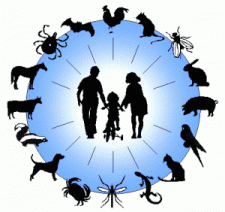Community for Emerging and Zoonotic Disease (CEZD) – What It Is and How to Get Involved
How does it work?
The CEZD uses a sophisticated computer algorithm within the KIWI technology (Knowledge Integration using Web Based Intelligence) on the Public Health Agency of Canada’s (PHAC) Canadian Network for Public Health Intelligence (CNPHI) platform, to search a large number of internet news stories daily. A series of raters, trained in animal, public and environmental health issues across many sectors, rate the issues/articles relative to their risk to Canadian animals and public health on a scale of 1-5 (1 not relevant to Canada, 5 extremely relevant to Canada). A weekly report featuring articles with an average relevance rating of 3 or more out of 5 is then shared with subscribers each week.

Why was CEZD developed?
CEZD was developed as a result of the ever increasing occurrence of emerging and zoonotic disease outbreaks globally. The community members are a diverse group of professionals with expertise in animal health, animal agriculture, public health and environmental health; they originate from the private sector, academia, multiple levels of government and industry associations. The goal of CEZD is to support Canada’s early warning, preparedness and response capabilities through the gathering of information, generation and distribution of timely intelligence reports.
CFIA currently funds the CEZD core team and PHAC provides the computer technology to support community collaboration; partners contribute their expertise, time and support, and all benefit from the collaboration opportunities and networking. OAHN is a community partner, and is actively engaged in its development.
Is CEZD working on any new opportunities?
The community creates the opportunity for discussion about emerging issues across sectors via several means:
- monthly teleconferences offer the chance to discuss emerging issues;
- a polling tool called “PING” is available to all members to ask others in the community their thoughts on specific items;
- the repository of historical information signals can be mined for analysis of trends; and
- webinar opportunities are being developed to share the work of members, explore opportunities to develop early warning systems and tools and expand the network.
The community also has two sub groups that are working on:
- Engagement and Outreach to grow the community and maximize its diversity; and
- Reports and Analysis to evaluate and determine the type of intelligence that is important for the community to generate and share.
CEZD continues to grow and develop. New members are welcomed and are encouraged to share their ideas, and take leadership within the community, to improve Canada’s ability to identify emerging threats early, so that actions can be taken sooner.
How does OAHN fit in with CEZD?
- OAHN website is used as a news source for animal health; CEZD core team analysts search OAHN daily as one of the news sources
- OAHN receives and uses information from the CEZD weekly intelligence reports
- OAHN leadership participates in the monthly calls held by CEZD, and the working groups
- Some OAHN networks are using the CEZD reports as an information source in determining emerging threats as discussion points for their calls.
- Some OAHN members are raters on the CEZD platform.
What could your role be?
Want to receive reports? Sign up to 1-2 page weekly email reports from CEZD.
Want to be a rater? If you are an animal health professional in Canada, you can apply to be a rater. It is easy, and does not take a large time commitment.
Other ways to take an active role in CEZD: Poll the community of experts in the event of a pressing issue; search the historical signals for trend; be part of the discussions and share resources.
Check out the CEZD on the CAHSS website https://www.cahss.ca/surveillance/emerging/ or Email CFIA.CEZD-CMEZ.ACIA@inspection.gc.ca for more information or to sign up.

